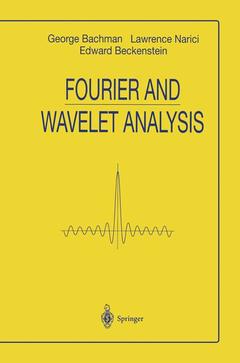Description
Fourier and Wavelet Analysis, 2000
Universitext Series
Authors: Bachmann George, Narici Lawrence, BECKENSTEIN EDWARD
Language: English
Subject for Fourier and Wavelet Analysis:
52.74 €
In Print (Delivery period: 15 days).
Add to cart
Fourier and Wavelet Analysis
Publication date: 09-2012
507 p. · 15.5x23.5 cm · Paperback
Publication date: 09-2012
507 p. · 15.5x23.5 cm · Paperback
94.94 €
Subject to availability at the publisher.
Add to cart
Fourier and wavelet analysis (universitext)
Publication date: 12-1999
507 p. · 15.5x23.5 cm
Publication date: 12-1999
507 p. · 15.5x23.5 cm
Description
/li>Contents
/li>
globalized Fejer's theorem; he showed that the Fourier series for any f E Ld-7I", 7I"] converges (C, 1) to f (t) a.e. The desire to do this was part of the reason that Lebesgue invented his integral; the theorem mentioned above was one of the first uses he made of it (Sec. 4.18). Denjoy, with the same motivation, extended the integral even further. Concurrently, the emerging point of view that things could be decom posed into waves and then reconstituted infused not just mathematics but all of science. It is impossible to quantify the role that this perspective played in the development of the physics of the nineteenth and twentieth centuries, but it was certainly great. Imagine physics without it. We develop the standard features of Fourier analysis-Fourier series, Fourier transform, Fourier sine and cosine transforms. We do NOT do it in the most elegant way. Instead, we develop it for the reader who has never seen them before. We cover more recent developments such as the discrete and fast Fourier transforms and wavelets in Chapters 6 and 7. Our treatment of these topics is strictly introductory, for the novice. (Wavelets for idiots?) To do them properly, especially the applications, would take at least a whole book.
1 Metrie and Normed Spaces.- 1.1 Metrie Spaces.- 1.2 Normed Spaces.- 1.3 Inner Product Spaces.- 1.4 Orthogonality.- 1.5 Linear Isometry.- 1.6 Holder and Minkowski Inequalities; Lpand lpSpaces..- 2 Analysis.- 2.1 Balls.- 2.2 Convergence and Continuity.- 2.3 Bounded Sets.- 2.4 Closure and Closed Sets.- 2.5 Open Sets.- 2.6 Completeness.- 2.7 Uniform Continuity.- 2.8 Compactness.- 2.9 Equivalent Norms.- 2.10 Direct Sums.- 3 Bases.- 3.1 Best Approximation.- 3.2 Orthogonal Complements and the Projection Theorem.- 3.3 Orthonormal Sequences.- 3.4 Orthonormal Bases.- 3.5 The Haar Basis.- 3.6 Unconditional Convergence.- 3.7 Orthogonal Direct Sums.- 3.8 Continuous Linear Maps.- 3.9 Dual Spaces.- 3.10 Adjoints.- 4 Fourier Series.- 4.1 Warmup.- 4.2 Fourier Sine Series and Cosine Series.- 4.3 Smoothness.- 4.4 The Riemann-Lebesgue Lemma.- 4.5 The Dirichlet and Fourier Kernels.- 4.6 Point wise Convergence of Fourier Series.- 4.7 Uniform Convergence.- 4.8 The Gibbs Phenomenon.- 4.9 — Divergent FourierSeries.- 4.10 Termwise Integration.- 4.11 Trigonometric vs. Fourier Series.- 4.12 Termwise Differentiation.- 4.13 Dido’s Dilemma.- 4.14 Other Kinds of Summability.- 4.15 Fejer Theory.- 4.16 The Smoothing Effect of (C, 1) Summation.- 4.17 Weierstrass’s Approximation Theorem.- 4.18 Lebesgue’s Pointwise Convergence Theorem.- 4.19 Higher Dimensions.- 4.20 Convergence of Multiple Series.- 5 The Fourier Transform.- 5.1 The Finite Fourier Transform.- 5.2 Convolution on T.- 5.3 The Exponential Form of Lebesgue’s Theorem.- 5.4 Motivation and Definition.- 5.5 Basics/Examplesv.- 5.6 The Fourier Transform and Residues.- 5.7 The Fourier Map.- 5.8 Convolution on R.- 5.9 Inversion, Exponential Form.- 5.10 Inversion, Trigonometric Form.- 5.11 (C, 1) Summability for Integrals.- 5.12 The Fejer-Lebesgue Inversion Theorem.- 5.13 Convergence Assistance.- 5.14 Approximate Identity.- 5.15 Transforms of Derivatives and Integrals.- 5.16 Fourier Sine and Cosine Transforms.- 5.17 Parseval’s Identities.- 5.18 TheL2Theory.- 5.19 The Plancherel Theorem.- 5.20 Point wise Inversion and Summability.- 5.21 — Sampling Theorem.- 5.22 The Mellin Transform.- 5.23 Variations.- 6 The Discrete and Fast Fourier Transforms.- 6.1 The Discrete Fourier Transform.- 6.2 The Inversion Theorem for the DFT.- 6.3 Cyclic Convolution.- 6.4 Fast Fourier Transform for N=2k.- 6.5 The Fast Fourier Transform for N=RC.- 7 Wavelets.- 7.1 Orthonormal Basis from One Function.- 7.2 Multiresolution Analysis.- 7.3 Mother Wavelets Yield Wavelet Bases.- 7.4 From MRA to Mother Wavelet.- 7.5 Construction of — Scaling Function with Compact Support.- 7.6 Shannon Wavelets.- 7.7 Riesz Bases and MRAs.- 7.8 Franklin Wavelets.- 7.9 Frames.- 7.10 Splines.- 7.11 The Continuous Wavelet Transform.
© 2024 LAVOISIER S.A.S.

